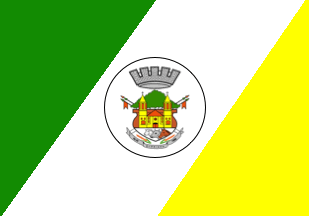 image by Ivan Sache, 18 July 2020
image by Ivan Sache, 18 July 2020 
Last modified: 2020-07-25 by ian macdonald
Keywords: rio grande do sul | glorinha |
Links: FOTW homepage |
search |
disclaimer and copyright |
write us |
mirrors
 image by Ivan Sache, 18 July 2020
image by Ivan Sache, 18 July 2020
The municipality of Glorinha (6,885 inhabitants in 2010; 192 sq. km) is located in the Porto Alegre Metropolitan Area, 50 km from Porto Alegre. Glorinha originates in the division of the municipality of Gravataí in 1834 in the districts of Costa da Sapucaia, Freguesia de Aldeia dos Anjos and Passo Grande, the latter being subsequently known as Rua da Glória. The "street" ("rua"), indeed a path, was lined with house forming a small village settled by colonists of Portuguese origin. The original chapel dedicated to Our Lady of Glory ("Glória") was rebuilt in 1906 as a parish church. Rua da Glória was then a busy place, being the only access to the northern coast of Rio Grande do Sul from Porto Alegre. Around 1910, the settlement was renamed Glorinha, for its patron saint. In 1936, the first macadamized street in the State (RS-030) linked Glorinha to Passo Grande. In the 1960s, Glorinha became the main milk producer in Rio Grande do Sul. The municipality of Glorinha was established by State Law No. 8,590 of 4 May 1988.
Ivan Sache, 24 March 2012
The flag and arms of Glorinha are prescribed by Municipal Law No. 103
promulgated on 23 April 1992.
Article 3.
The municipal coat of arms
has the following specifications:
I. Shield shaped like a mate calabash,
brown in the upper part and white in the lower part, featuring:
a) the front
facade of the municipality's main church, yellow and orange, covering nearly all
the shield's upper part.
b) three cattle's heads in the lower part, a white
sheep, a gray bovine, and a brown horse, all outlined in black, on a white
field.
II. The coat of arms is also composed of:
a) the canopy of a fig
tree over the shield's upper part, like mate in the calabash, placed behind the
church's towers.
b) four black lances, fixed parallel two by two at each end
of the fig tree's canopy, the upper with a green and orange finial, the lower
with a green finial and an orange pennant.
c) a crown-shaped citadel with
four central spans, built of white bricks masoned in black, surmounting the
shield.
d) a gray scroll in three parts, with the writing "04.05 GLORINHA
1988" placed beneath the shield.
Article 4.
The municipal flag obeys
the following description and rules.
I. The flag is composed of three panels;
green white and yellow, in usual shades, the green and yellow panels forming
right-angled triangles and the white panel a quadrilateral ascending between the
two triangles, running from the green triangle's right angle in the flag's upper
left to the yellow triangle's right angle in the flag's lower right.
II. On
the white panel, in the flag's center, a white disk with the perimeter outlined
in black, charged with the coat of arms.
III. The two sides of the flag shall
be exactly identical, the one mirroring the other.
Article 5.
The flag
shall be made on the template of the national flag, in compliance with the
following specifications.
I. The flag's width shall be of 14 units.
II.
The flag's length shall be of 20 units.
III. The axis of the circle drawn on
the white panel of the ascending quadrilateral shall be located exactly in the
flag's center and have a radius of 3.25 units.
IV. The circle's outline shall
be of 1.20 unit.
V. The opposed side of the green right-angled triangle, in
the upper left part, shall be exactly of 10 units and the adjacent side of 14
units; the same is true for the yellow right-angled triangle, in the lower right
part.
Article 6.
For official use, the flag shall have each unit of 8
cm x 6 cm.
Article 8.
The coat of arms highlights features of the
municipality, representing more specifically:
a) The calabash-shaped shield:
people's hospitality
b) The citadel and lances: sovereignty and defense of
its interests
c) The church: the inhabitant's Christian education
d) The
fig tree: downtown's landmark
e) Animals and rice: the agricultural
production, its basic source of income
f) Writings: identification and date
of creation.
Article 9,
The municipal flag, beyond the colors of the
coat of arms, is composed of three main colors: green, white and yellow, which
were established as the municipality's official colors, representing:
a)
Green: the preserved natural environment, its fields and forests
b) White:
the local tranquillity, faith and hope
c) Yellow: productive fields supplying
income and prosperity.
https://leismunicipais.com.br/a/rs/g/glorinha/lei-ordinaria/1992/11/103/lei-ordinaria-n-103-1992-institui-o-brasao-e-a-bandeira-municipal-como-simbolos-oficiais-do-municipio-e-da-outras-providencias
Leis Municipais database
The emblematic tree is locally known as Zé
Gomes' fig-tree.
Photos
http://glorinha.rs.gov.br/gov/candidatas-fazem-tour-pelo-municipio-de-glorinha-guiado-pelo-professor-marcio-knobeloch
Ivan Sache, 18 July 2020